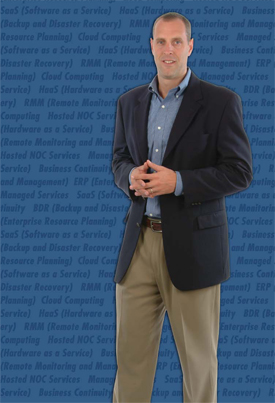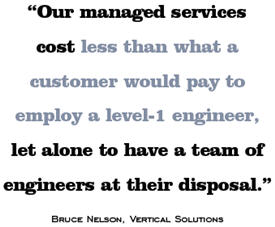The Managed Services Model Has Changed — Have You?
By Jay McCall, Business Solutions magazine.
By evolving its managed services, this MSP continues to win customers and is reaping a projected 25% increase in profit this year.

Five years ago Vertical Solutions was a break-fix VAR that made the decision to get into selling managed services. As much as Bruce Nelson, the president of this 30-employee company could tell you about that experience — and there were several lessons he had to learn along the way — it’s not the story you really need to hear from Nelson. If you’ve been reading Business Solutions for any time now, you know we’ve covered that topic several times and from several angles. Nelson’s story centers around a question so many VARs-turned-MSPs ask themselves once they’ve become accustomed to the recurring revenue business model: “What’s next?” The question is usually followed by concerns about how they can distinguish themselves from other managed services providers and prevent their managed services offering from becoming commoditized, much like so many have experienced with their hardware margins. All that to tell you this: If the commoditization of managed services is something you’ve been fretting over, Nelson’s story offers hope.
What’s Next In Managed Services?
About 18 months ago, Nelson started taking a mental inventory of his business. His company was established enough in managed services that it had handled hundreds of thousands of tickets, and he had become comfortable with his technology vendors (e.g. remote monitoring and management, professional services automation, backup and disaster recovery). According to Nelson, he started asking himself, “What challenges do my clients still have that I’m not currently helping them with, but could be?” As he started reflecting on some of the trends he’d been hearing about among larger enterprises moving toward thin-client computing and pushing applications and IT infrastructure to remote data centers and to the cloud, the “aha moment” came to him. “What’s happening in the enterprise is similar to what’s happening with consumers. People are using cloudbased services such as iTunes, Facebook, or Snapfish to manage their music, social media, and photos. Why can’t my SMB customers use my company to have that same experience with all of their IT needs?” To some extent, he was already providing some of these services, such as saving a copy of his customers’ data in the cloud for disaster recovery purposes. But, why couldn’t his customers put more computing resources such as servers and applications in the cloud and pay Vertical Solutions to manage it?
Following his revelation, Nelson realized three things needed to happen before this could become a reality:
1. He needed to make sure a full managed services offering made business sense for his customers as well as his company. “We spent a few months creating various scenarios and price points and comparing what our clients were already paying for traditional managed services with this new model,” says Nelson. “The increased level of security and services for a similar investment really jumped out to us. Over a five-year period the cost tends to be fairly close, but when you look at the level of services you get in a hosted scenario, it’s almost a no-brainer to make the move to the cloud.”
2. Nelson needed to find the right cloud provider that would be channel-friendly and provide reliable service. “After researching several options, we selected Expedient as our private cloud provider,” says Nelson. “They have a topnotch data center that meets all the latest certification requirements [e.g. SSAE 16], and they have a reputation for working well with the channel, which we were able to verify through conversations with their other customers.”
3. He would have to move all of his IT infrastructure and applications to the cloud before he could expect his customers to try it. “Once we found a cloud service provider we trusted, we started migrating our various cloudbased solutions to their data center over a six-month period,” he says. “The biggest challenge we ran into during this transition was pushback from some of our team members. We have a very technical group, but we learned that some people are fearful of change, so we made sure to keep in regular contact with the group and reinforce that this was how we were going to run the business. Eventually, we were able to get everyone’s buy-in.”

Today, Nelson and his team use only a terminal server to access their business applications. “I can access all my applications — email, Office documents, CRM [customer relationship management], or ERP [enterprise resource planning] from any Internet-enabled device,” he says. Nelson has found that demonstrating this to his clients goes a long way in helping overcome objections about accessing data in the cloud. “After I demonstrate how I access my applications, I tell them, ‘If I lose this laptop, my client data is not on this device — it’s totally secure from data theft.’” He then follows up with, “Does that meet your security requirements?’”
Putting Next Gen Managed Services Into Practice
After vetting out the processes and pricing of moving his clients to the cloud, Nelson and his team were ready to start talking with customers. “The best candidates were the ones whose servers were approaching their end of life, and we were already planning to talk about this subject anyway,” he says. He was surprised to find so many of his customers were very open to the idea of moving their server to the cloud, which Nelson credits to the trend of how consumers are interacting with cloud-based services.
One of the lessons Vertical Solutions learned early on is that it doesn’t work to allow customers to piecemeal their outsourced services — and to pay you to manage one piece and another company to manage another piece (e.g. a customer that buys its application from one provider, but wants to use your company to host the application). “We had some pushback from one company about the cost of our Office 365 service, which was $6 per user per month — $2 more per month than what the local cable company was offering,” he says. Nelson was able to overcome this objection by contrasting the cable company’s service reputation with his company’s reputation. “Do you really want to call your cable company when you need support for your documents, email, or other critical business processes?” he asked the customer.
Nelson has also found that larger companies are not a good fit for this fully hosted service offering. “Once a company surpasses 250 employees, it usually has enough capital to afford its own internal resources,” he says. “The sweet spot is the company with 25 to 250 employees that needs high availability, but doesn’t have the internal IT resources to meet this need.” The average cost for Vertical Solutions’ typical client (around 30 users) is around $3,500 per month for full monitoring and extended help desk services. “Our managed services cost less than what a customer would pay to employ a level-1 engineer, let alone to have a team of engineers at their disposal,” says Nelson.
Probably the biggest obstacle Vertical Solutions has had to overcome since offering cloud-based managed services is the emotional component of taking a client’s physical server out of their office. “We actually had to take one customer to our cloud provider’s data center so they could see for themselves the security measures that are in place, plus the state-of-the-art equipment, the air-conditioned server rooms, and the redundant power supplies. Once they saw all that, they told us they wished they had made the move sooner.”
To complement his move to a fully cloud-based managed services model, Nelson actively solicited customer feedback on what he could do to improve his customer service. “Based on customers’ feedback, we made the necessary adjustments to our controls and workflows,” says Nelson. “Specifically, we made sure that our staffing size, skill set, and mix of level-1, level-2, and level-3 support exceeded our customers’ expectations.” According to Nelson, it paid off because he never receives complaints about Vertical Solutions’ technical services.
The MSP expects its move toward hosted solutions to continue building momentum. “We view this move as the foundation for the new anytime, anywhere office,” he says. “The world is shrinking and users are accessing their IT systems from various mobile devices — and this trend will only continue. Our solutions and services provide the platform for this transformation.”

